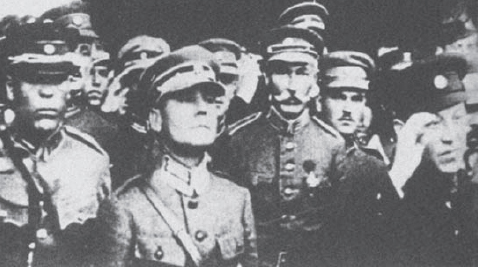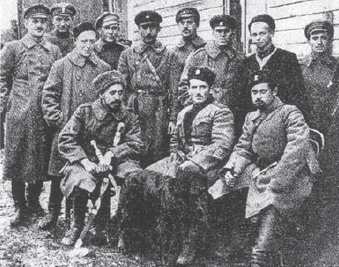
The Commander-in-Chief of the UNR Army (Armiia Ukraïnskoï Narodnoï Respubliky) was Directory Chairman Symon Petliura, assisted by Col Volodymyr Salskyi as Minister of War. The Army commander was MajGen (later LtGen) Mykhailo Omelianovych-Pavlenko, with MajGen Volodymyr Sinkler as Chief of General Staff. In May 1920 the 40,000-strong UNR Regular Army (Dieva Armiya UNR) was reorganized with Polish support into 1st–6th Rifle Divs, later joined by the independent Cavalry and 1st MG Divs, the latter formed from Rifle replacement brigades. Two UNR regimental-strength divisions fought alongside the Poles: 3rd Div with Sixth Army (Apr–July 1920), and 6th Div with Second and Third Armies (Apr–August). The 23,000-strong UNR army, defeated on 11–12 Nov 1920 by Bolshevik forces, retreated into Eastern Galicia on 21 Nov, was interned until 24 Aug 1924, and later disbanded. (Meanwhile, some 40,000 guerrillas operated in Bolshevik-occupied Ukraine until 1925.)
A UNR rifle division had an HQ; HQ troops (cav regt; engineer, medical, supply, veterinary and legal HQs); and 3 rifle and 1 art brigades. The cav regt had an HQ; 4 cav sqns (company-equivalent, each with 4 ptns); an MG sqn (2 ptns) and a technical detachment (2 sapper-signals platoons). A divisional engineer HQ comprised an armd car bn; railway eng bn; air det (sqn); technical regt; radio bn; and an MT column. A rifle bde had an HQ; technical co; and 3 rifle battalions. A rifle bn comprised an HQ; cav half-company; technical co; 3 rifle cos (each with 3 rifle, 1 grenade & 1 MG ptns); MG co (4 ptns); and a recce co (2 rifle ptns). An art bde had an HQ; 3 light and 1 heavy regts (each with 1 howitzer and 3 field btys); 1 MG co; and a horse art bty with an MG platoon. Each rifle div was allocated a replacement rifle bde, but none of these achieved operational status. (Note that these theoretical establishments were rarely sustained in wartime.)
By Nov 1920 the Ukrainian Air Service (Povitrovy Fliota UNR) was reduced to one squadron (Aviatsyiya Zagin) with 8 aircraft. The Ukrainian Navy (Ukrainska Viyskova Fliota), deprived of seagoing ships since Dec 1918, manned the armoured train ‘Chornomorets’, a Naval Flotilla with two infantry companies, and other shore units in 1st Rifle Division. The Finance Ministry operated the company-sized Mogyliv-Podilska Border Brigade.

Symon Petliura (first right), 6th Rifle Div commander Col Marko Bezruchko (second left) and other UNR officers attend the victory parade by the Ukrainian 6th Rifle Div in Kyiv, May 1920. Petliura wears the M1919 uniform, other officers the M1920 pattern, with loose cap cords. HQ Staff Col Mikola Yanchevsky (second right, with sweeping moustache) has unofficial white shoulder-strap piping. Ukrainian officers were forbidden to wear the medals of former enemies of Ukraine, except for the two highest awards for military gallantry: the Russian Order of St George (worn by Col Yanchevsky) and the Austro-Hungarian Order of Maria-Theresia. (Eugen Pinak Collection)
Three foreign contingents fought with the UNR Army in Nov 1920: LtGen Permikin’s White Russian Third Army; Col Yakovlev’s Combined Cossack Cav Div, formed in Oct 1920; and the Polish-Ukrainian Volunteer Detachment under Polish LtCol Walery Sławek.
The Galician Army (Halytska Armiya – HA) was formed on 13 Nov 1918 in the ZUNR from former Austro-Hungarian Army personnel, led by a series of commanders, principally MajGen Mykhailo Omelianovych-Pavlenko (10 Dec 1918–7 June 1919). Eastern Galicia had 12 military districts, and the HA was organized in Jan 1919 into 1st–10th and 1st Mtn Bdes (each with anything from 2 to 19 infantry battalions), grouped in Feb 1919 into I–III Corps.
On 14 May 1919 Polish forces, strengthened by Haller’s ‘Blue Army’ divisions from France, launched an offensive. The HA counterattacked at Czortków (Ukr, Chortkiv) on 7 June, but Polish forces resumed their advance on 28 June. They forced the 85,000-strong Galician Army into western Ukraine on 17 July, where it joined the UNR Army. The HA captured Kyiv on 30 August 1919, but, unwilling to accept a UNR alliance with Poland, it turned to the White Russian Gen Denikin on 30 November 1919; since 6 Nov it had been redesignated the Ukrainian Galician Army (Ukrayinska Halytska Armiya – UHA). When Denikin retreated, the UHA, based in Eastern Podolia and reduced by typhus to about 5,000 men, joined the Red Army on 7 Feb 1920 as the Red Ukrainian Galician Army (Chervona Ukrayinska Halytska Armiya – ChUHA) in order to fight the Poles.
The ChUHA reorganized its depleted strength into 1st Bde (rifle regts numbered 1, 3 & 7; later 1–3); 2nd Bde (6, 9 & 10 Regts; later 4–6); and 3rd Bde (2, 8 & 11 Regts; later 7–9). The Polish Cavalry (later 1st Cav) Div defeated the Russian 44th and 58th (both Ukrainian) Rifle Divs and the ChUHA at the battle of Koziatyn (Ukr, Kozystyn) in Volhynia on 25–30 Apr 1920, whereupon the ChUHA disintegrated; the 1st Bde surrendered, and the rest deserted.
Following the BNR’s declaration of independence from Russia on 25 Mar 1918, Belarusian units formed in Belarus and neighbouring states. After the Bolshevik invasion of 15 Jan 1919 the BNR government fled to Riga, Latvia, where it signed an alliance with Poland on 23 Feb 1920. Major-General Stanisław Bułak-Bałachowicz, a colourful and talented Polish commander, led the small Belarusian People’s Army (Belaruskaya Narodna Armiya – BNA, redesignated the Bułak-Bałachowicz Operational Group), which comprised some 2,000 infantry and 800 cavalry. The Group fought with Polish Third Army from 9 June 1920 in Western Belarus; at Włodawa on 30 Aug during the Battle of Warsaw; at Kamień Koszyrski (Ukr, Kamin-Kashyrski) on 15 Sept; at Lubieszów (Ukr, Liubeshiv) on 21 Sept during the battle of the Niemen; and captured Pinsk on 26 September. On 5 Nov, Bułak-Bałachowicz led the BNA, with Don Cossacks and Russians formed into a 14,750-strong Russian People’s Volunteer Army (Russkaya Narodnaya Dobrovolcheskaya Armiya), into Belarus. Following an unsuccessful attempt to revive BNR independence at Mazyr on 12 Nov 1920, Bułak-Bałachowicz retreated to Poland, where he was interned.

Stanisław Bułak-Bałachowicz (front row, middle), the commander of the Belarusian People’s Army in summer 1920, relaxes with members of his regiment in Estonia, 1919, while serving with the White Russian North-Western Army. This charismatic adventurer wears a kubanka, and a khaki French edged with black lambswool; under magnification, five gold wound stripes can be seen above his left cuff. Bułak-Bałachowicz was a gifted, daring and successful commander; after fighting for Poland in September 1939, he was shot by the Germans in May 1940. (Author’s collection)
GHQ: 1, 2 Replacement Rifle Bdes (forming); Technical Troops (Armd Car Bn forming; Karmeliuk, Zaporizhets, Chornomorets Armd Trains; Sigs Co; 1, 2 Railway Eng Cos; 1, 2 MT Cols; 1 Zaporizhia Air Detachment).
1 Zaporizhia Rifle Div: 1 Zaporizhia Rifle Bde (1–3 Bns); 2 Zaporizhia Rifle Bde (4–6 Bns); 3 Zaporizhia Rifle Bde (7–9 Bns, 22 Sept 1920); 1 Black Zaporizhia Cav Regt; 1 Art Bde (1 Art Bn); 1 Tech Bn; Naval Flotilla (Infantry).
2 Volhynia Rifle Div: 4 Greycoat Rifle Bde (10 Bn, 11 Greycoat Bn, 12 ‘Italian’ Bn); 5 Black Sea Rifle Bde (13–15 Bns); 6 Rifle Bde (16 Bn, 18 Oct 1920); 2 Ivan Mazepa Cav Regt; 2 Art Bde (4 Art Bn); 2 Tech Company.
3 Iron Rifle Div: 7 Rifle Bde (19–21 Bns); 8 Rifle Bde (22–24 Bns); 9 Rifle Bde (25, 26, MG Bns); 3 Cav Regt (forming); 3 Art Bde (7, 9 Art Battalions).
4 Kiev Rifle Div: 10 Rifle Bde (28–30 Bns); 11 Rifle Bde (31, 32 Bns, 19 Sept 1920); 4 Cav Regt; 4 Art Bde (10, 11 Art Bns); 4 Tech Battalion.
5 Kherson Rifle Div (25 May 1920): 13 Rifle Bde (37 Bn); 14 Rifle Bde (40–? Bns, 17 Nov 1920); 15 Rifle Bde (43–? Bns, 20 Oct 1920); 5 Cav Regt (forming); 5 Art Bde (13 Art Bn); 5 Tech Bn (forming).
6 Rifle Div: 16 Rifle Bde (46, 47 Bns); 17 Rifle Bde (49, 50 Bns); 6 Kost’ Gordiyenko Cav Bn; 6 Art Bde (16, 17 Art Bns); 6 Tech Battalion.
1 Machine-Gun Div (9 Sept 1920): 1 MG Bde (1, 2 MG Bns, 19 Sept); 2 MG Bde (3, 4 MG Bns, 19 Sept); Art Bde (2 batteries); Tech Battalion.
Independent Cavalry Division (30 June 1920): 1 Cav Bde (1 Maksym Zalizniak, 2 Zaporizhia Cav Regts); 2 Cav Bde (3 Independent ‘Colonel Udovychenko’, 4 Ivan Sirko Cav Regts); Plastun Regt (inf bn); 1 Mtn Horse Art Bn (2 batteries).
Russian Third Army (1, 2 Rifle Divs) & Combined Cossack Cav Div (Oct–Nov 1920); Polish-Ukrainian Vol Det (Nov 1920)